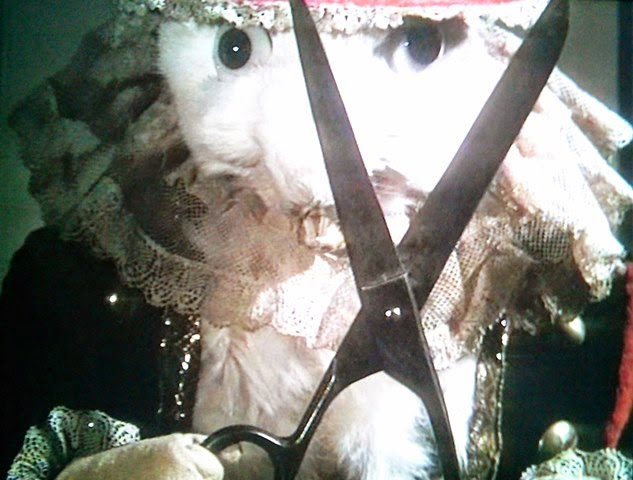(#WhatThomWatched eight!)
Alice (Něco z Alenky)
(Jan Svankmajer, 1988; English version disc from First Run Features)
Lewis Carroll’s beloved Alice in Wonderland and Through the Looking-Glass are well known, and IMDb lists at least 60 movie adaptations of one or the other, counting shorts and spoofs. So what are the defining parameters of Jan Svankmajer’s version? Alice is portrayed by an actual little girl, Kristýna Kohoutová; she is the only human in the movie. Her voice (Camilla Power in the English language version) narrates the film, and all attributions (“she said”/”said the White Rabbit”) are spoken by her lips in closeup. All of the creatures she meets in Wonderland are dolls (or other anthropomorphized objects), usually stop-motion animated. And in a brilliantly natural choice, Alice herself becomes a doll when she shrinks.
Svankmajer is a Czech surrealist genius. His inspired retelling of Alice does not reproduce much of the specific wordplay in the books, preserving just a few of the puns and none of the poetry; only a handful of the famous characters appear, all from the first book (none from Through the Looking-Glass); Alice’s long and digressive internal monologues are cut; and the most-repeated symbols are Svankmajer additions (desks with drawers with knobs that break off, to pick a notable example). But his is truly a transcendent Alice: she is a child, capturing precisely the stubborn unpleasantness of the literary Alice, and she is caught in a nightmare, or day-dreaming nightmarish things, or a measure of each. There is nothing cute about Alice in Carroll; he pushed any of the Victorian preciousness demanded by the readers of his day off of her and off the thoroughly unlikable creatures she meets and onto himself — consider: the syrupy-sickly-sweet parts of Alice come in the little poems (the Liddel poems) and the prefaces he writes in his own voice, almost as if by pouring all of his sentiment out on the real Liddel sisters (and, in letters, on all the child-fans in his life), he can treat the fictive Alice with cold detachment and (via the Queens, both Red and Of Hearts) cruelty. Svankmajer puts this on screen like no other filmmaker. His Alice, and her predicaments, and her treatment at the hands of Wonderland’s denizens, all channel Carroll.
Reminds me of:
I am very serious about Alice in Wonderland and Lewis Carroll. Early in my DVD-collecting days, I started creating informal D-I-Y sets of related movies, and the first one was an attempt to get every version of Alice released on disc at that time (which wasn’t too terribly hard — I believe there were seven, including the Disney cartoon.) I own multiple editions of the book including the two invaluable Martin Gardner Annotated Alice volumes. This is my favorite movie version. For all that it deviates from the books’ familiar set pieces, it captures Alice — more, it creates a cinematic equivalent — to a degree that more literal visualizations do not.
This is one of those movies that creates the protagonist’s dream world out of a clutter of objects scattered around the “real” world; the next example that comes readily to my mind is another mature-movie-masquerading-as-child-fare, Gilliam’s Time Bandits (in which Kevin’s not-dream can be seen to have been constructed out of toys and images in his room). All of Alice’s Wonderland starts in a dreary, paint-peeling, ruin of a room strewn with Richter Anchor Stone blocks (a 19th-century German building toy which my kids also played with) and a taxidermied rabbit in a glass case; she then plunges into and through and past and out of a series of such rooms, with elements repeated and reused. Some of these items seemed to hail from my own dreams, some from other movies — I realize there is a limited vocabulary of clutter-y objects, but the cases of mounted butterflies instantly conjured another Czech surrealist masterpiece, Vera Chytilová's Daisies (Sedmikrásky).
But then — the guilt!
Alice was Svankmajer’s first feature-length movie after years of critically acclaimed shorts. But it was just a warm-up for several subsequent full-lengths, some also based on classical source material and some just from his own imagination, none of which I’ve seen. It actually takes me some time to work up the guts to experience his nightmarish visions, but I’ve got to seek out these more recent films on disc — especially Lesson Faust, his take on the Faust legend, and Lunacy, about an insane asylum.
I’ve also never even bothered with Tim Burton’s Disney rewrite from 2010, despite being impressed with actress Mia Wasikowska (in movies like Jane Eyre) and (usually) liking a Burton production at least for its visual sense. Correction: I tried to watch it once and turned it off after twenty stultifying minutes. Not a whit of what makes these books so vital had made it to the screen; where Carroll’s obnoxious seven-year-old is the heart of both Alice’s darkly humorous edge and the perfect foil for his nonsense logic, the "grown-up" version makes nonsense of his nonsense. I guess my Alice collection will never be complete . . . . and now that I think about it, I don’t feel guilty in the least.
Pitch:
That rabbit. Glass eyes were never so unnerving. Between this and Donnie Darko, it's a wonder that anyone can keep a pet rabbit in the house and still sleep at night.
















No comments:
Post a Comment